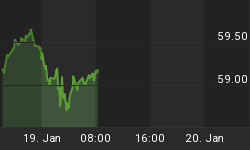Okay, I'm sure you've heard that the trend is up on the Dow Jones Industrial Average and other U.S. indices by now, but do you know how folks are coming to that conclusion? Today I'm going to outline some of the basic trend discovery metrics and how they reveal the trend for us. "The trend is your friend" is the old saying, and it's an old saying for a very good reason: it's the truth!
The very long term secular trend on the Dow, the long term primary cyclical trend, the intermediate trend, the short term daily trend, they're ALL HIGHER! Sounds fantastic, right? A great money making opportunity, right?
Well, while it's true that you've really got to screw up big time in order to lose money when trading with the trend, and the opposite (you've got to be extremely good and quick to make money trading against the trend), all trends eventually do come to an end - hence the additional tack-on to the old saying ". . . until it isn't".
Just when you thought the getting is good, kabam!
Nevertheless, the trend is still up on the DJIA, but by what criteria do I make that claim? Perhaps the most important metric, and not by chance, is the price pattern of higher lows and higher highs. When you have a pattern of higher lows and higher highs, you can safely say that, by the most basic of TA criteria, the trend is higher. In fact, we can then draw a line connecting those higher lows, and, with that, we have the basic rising trendline that also illustrates the rising trend. We can draw trendlines off intraday price extremes, or refine them with filtering techniques eliminating those price extremes by using a line only chart, or by only connecting candlestick bodies, for example. We can also get "sophisticated", and use regression analysis like Raff Regression Channels. Sometimes regression channels line up with basic trendlines, and sometimes they don't. Each technical analyst needs to compare and contrast when they don't, considering length, number of touches, and slope, and then chose the best fit. In my opinion, the best representation of the current trend on the DJIA is reached using Raff Regression Analysis. Take a look and see what you think.
The 55 day simple moving average is boldly confirming the lower boundary of the rising channel, but the trend-momentum indicators shown on that chart are not. The falling ADX, being the slowest of the three indicators shown, is a warning of a possible imminent trend break; the RSI, being the quickest of the three, has broken down out of its channeling pattern already; and the longer term, 'smoothed' version of the MACD, using Martin Pring's parameters, is also hinting at an 'end-of-the-road' for the current trend (I say "hinting" since it could still 'hook' back higher as it often does and has done on this very same chart).
While it is common for the RSI to slightly lead price, that's not a guarantee and is one example of where a whipsaw might come from. Combined with what the ADX and MACD are telling us though, it's worth paying heed. The next step would be a violation of the rising channel's lower boundary, but not even that is guaranteed since violations can just as well be temporary as they can be legitimate trend breaks. What's more, not even a legitimate, confirmed trend break means a reversal! Steep up-trends like the one we're witnessing often 'break' into sideways consolidations! Trendlines that break in combination with pattern breakdowns are more reliable predictors of a reversal though, so if the Dow were to run back up and put in a double top . . .
Based on these basic TA trend identifiers, I think it's fair to say that the trend is still higher, but we might be well advised to add the word "barely" to that statement. In my opinion, the key to negating that affirmation at this point is a real trend break in price, after which a backtest, snapback, or throwback, as they're also called, to the original rising trendline is a common expectation (in the case of the regression channel, we could also see the same to the mid-channel regression line before the break). Once things have progressed that far, the main question then becomes one of whether the breakdown is simply a reactionary counter trend move, or the beginning of something bigger, and we'd be looking at measuring techniques like normal reaction retracement expectations for clues on that, as well as at the basic pattern of lower highs and lower lows . . . which brings us back to do (but the inverse in this case).
All eyes are most assuredly on the current accelerated intermediate trend channel and I dare say that no sane swing trading bull would be happy at all about the prospect of getting trapped long at these levels, especially when keeping in mind the very real possibility of a primary intermediate downtrend ultimately developing out of the current situation.
When contemplating things from a longer term time frame, it's not difficult to imagine that scenario.
I'll have more on the subject this coming weekend on my blog. Hope to see you there.
Related Study Materials:
http://en.wikipedia.org/wiki/Market_trend
http://en.wikipedia.org/wiki/Trend_line_%28technical_analysis%29
http://www.investopedia.com/university/dowtheory/dowtheory2.asp
http://www.investopedia.com/articles/technical/03/060303.asp
http://www.investopedia.com/articles/trading/06/trendlines.asp
http://www.investopedia.com/terms/c/channel.asp
http://stockcharts.com/school/doku.php?id=chart_school:chart_analysis:trend_lines
http://stockcharts.com/help/doku.php?id=chart_school:chart_analysis:raff_regression_chan
http://stockcharts.com/school/doku.php?id=chart_school:technical_indicators:average_directional_
http://stockcharts.com/school/doku.php?id=chart_school:technical_indicators:relative_strength_in
http://stockcharts.com/help/doku.php?id=chart_school:technical_indicators:macd-histogram


















